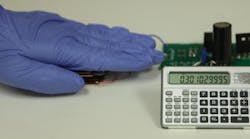>> Website Resources
.. >> Library: TechXchange
.. .. >> TechXchange: Power Management
.. .. .. >> Topic: Energy Harvesting
Researchers from the Georgia Institute of Technology has developed a power management system that could allow fitness bands and smart watches to harvest energy from human motions like running, walking, or tapping your fingers.
The research, published last month in the journal Nature Communications, could significantly increase the efficiency of triboelectric generators—tiny electronic devices that convert body movements and mechanical vibrations into electricity. The team reports that their new power management system can increase the efficiency of these devices from about one percent up to 60%.
Zhong Ling Wang, a professor in the Georgia Tech School of Materials Science and Engineering, led the development of the team's first triboelectric nanogenerators in 2012. Since then, Wang and his colleagues have invented several generators that take advantage of the triboelectric effect, or the property of certain materials to produce an electric current when rubbed against each other. Earlier this month, the research team developed a flag that could generate electricity by flapping in the wind. And last year, the researchers created a fabric that could harvest energy from human motion.
The new power management system has two stages. First, it captures alternating current from a triboelectric generator in a small capacitor. When the capacitor is full, a circuit funnels the electricity into a larger capacitor or battery. This second storage device then supplies direct current at the low voltages required for portable electronics and wearable devices.
The research could represent a major step toward solving the tricky problem of harvesting energy from irregular human motion. Ordinarily, alternating current can be converted into direct current using a transformer. But normal transformers require a constant number of cycles per second. By contrast, walking or finger tapping produce mechanical energy with fluctuating amplitude and variable frequencies.
The two-stage design of the new system can account for this problem, says Simiao Niu, a Georgia Tech graduate research assistant. “The first stage of our system is matched to the triboelectric nanogenerator,” he says, “and the second stage is matched to the application it will be powering.”
The power management system is capable of amplifying the very small electric current produced by triboelectric generators—up to 330 times more power output than the generator alone. When tested with finger tapping, the system generated a continuous direct current of 1.044 mW. The system needs a small amount of power to work, but the milliwatt-level power is more than enough to compensate, says Niu.
"It doesn't matter what kind of mechanical motion or what frequency of mechanical motion you have, as long as the energy input is high," says Niu. The system also helps to convert the high-voltage and low-current power from triboelectric generators for low-voltage, high-current portable electronics.
Wang says that the next step for the power management system, which has only been confirmed in a proof-of-concept experiment, will be to shrink the circuitry to the point where it can be used in an actual device. He adds that the system is also compatible with piezoelectric and pyroelectric generators, which also produce alternating current.
>> Website Resources
.. >> Library: TechXchange
.. .. >> TechXchange: Power Management
.. .. .. >> Topic: Energy Harvesting


